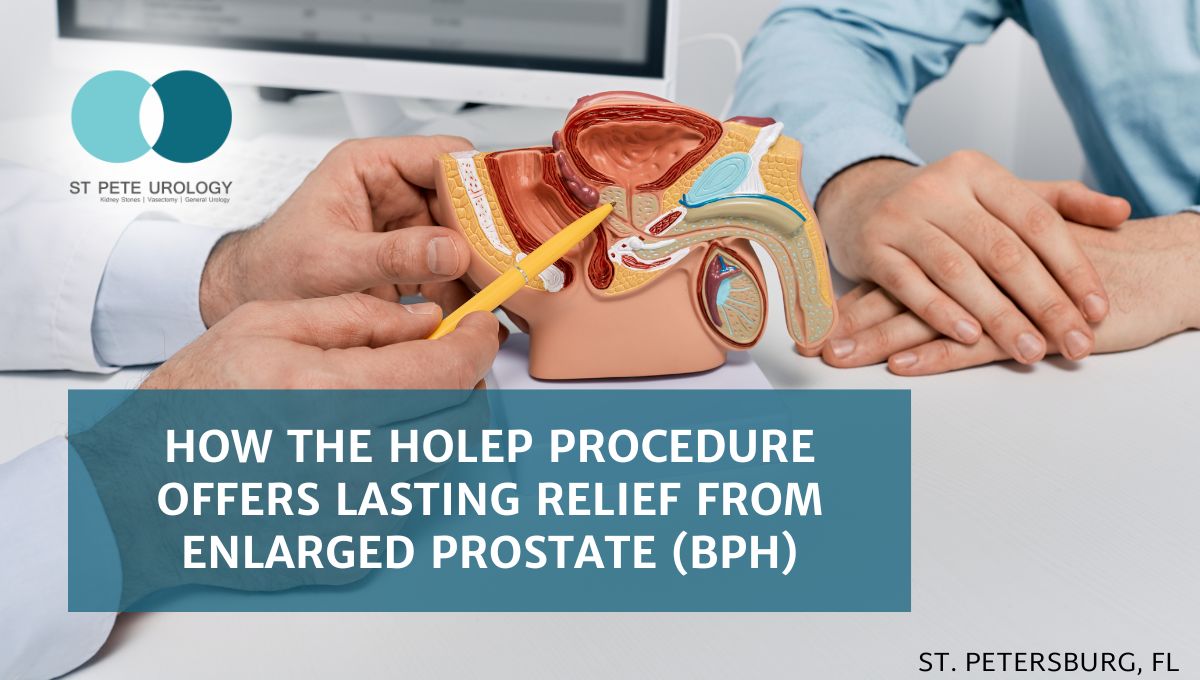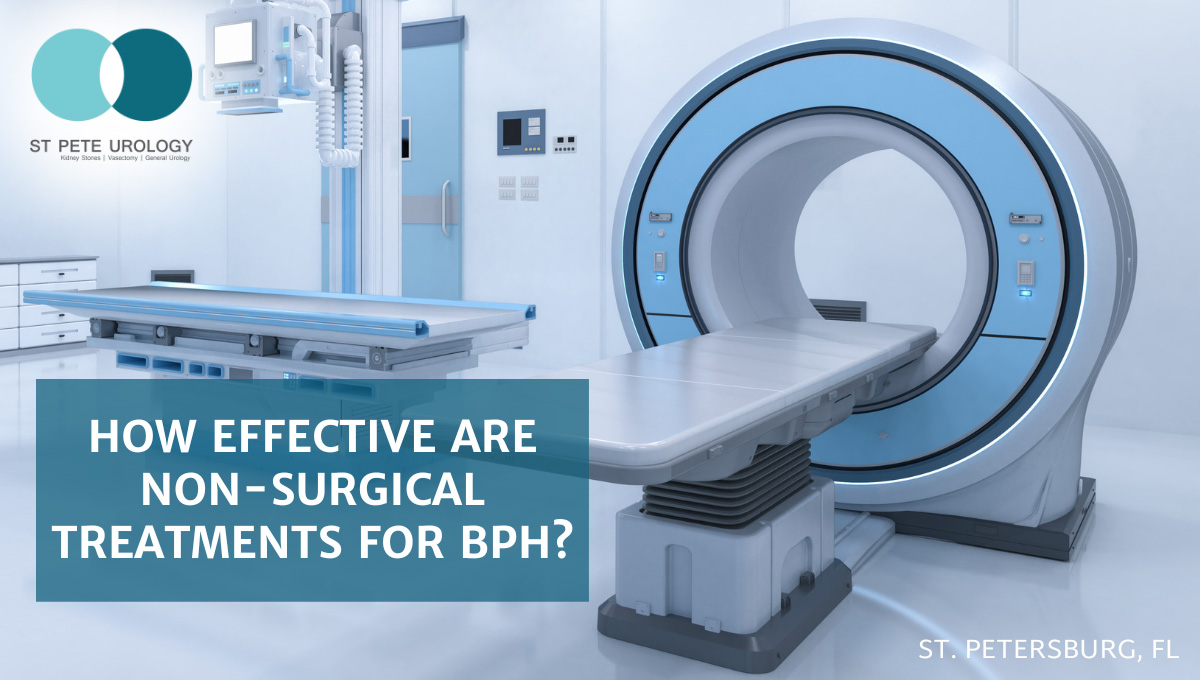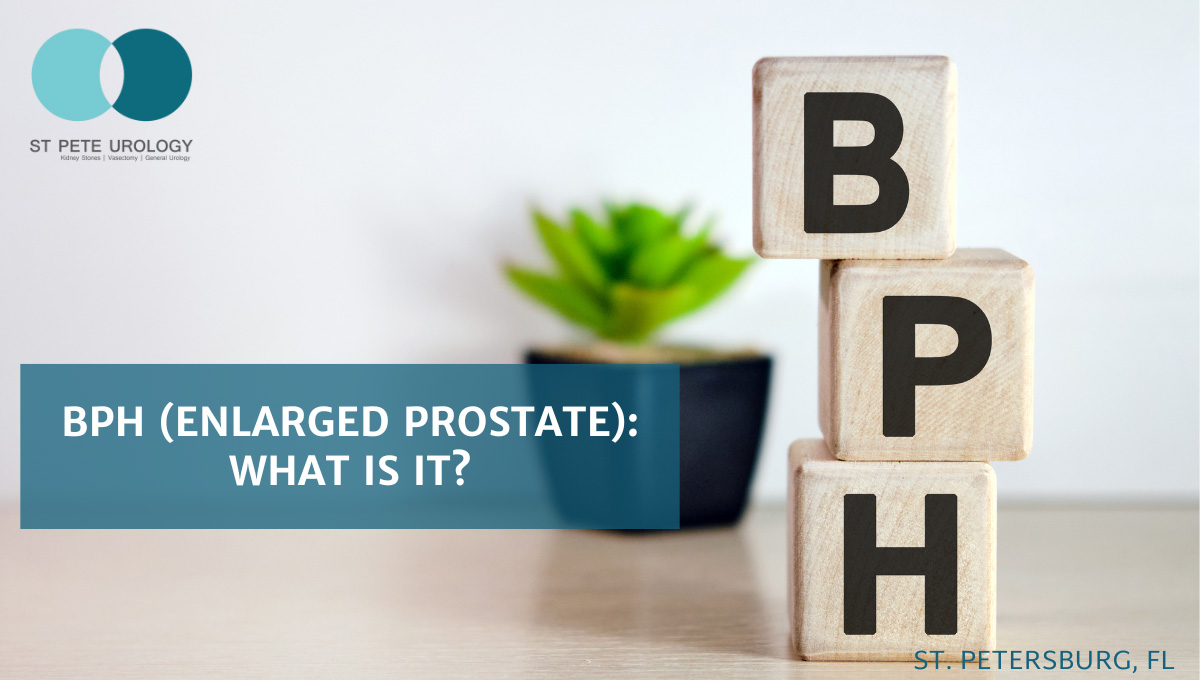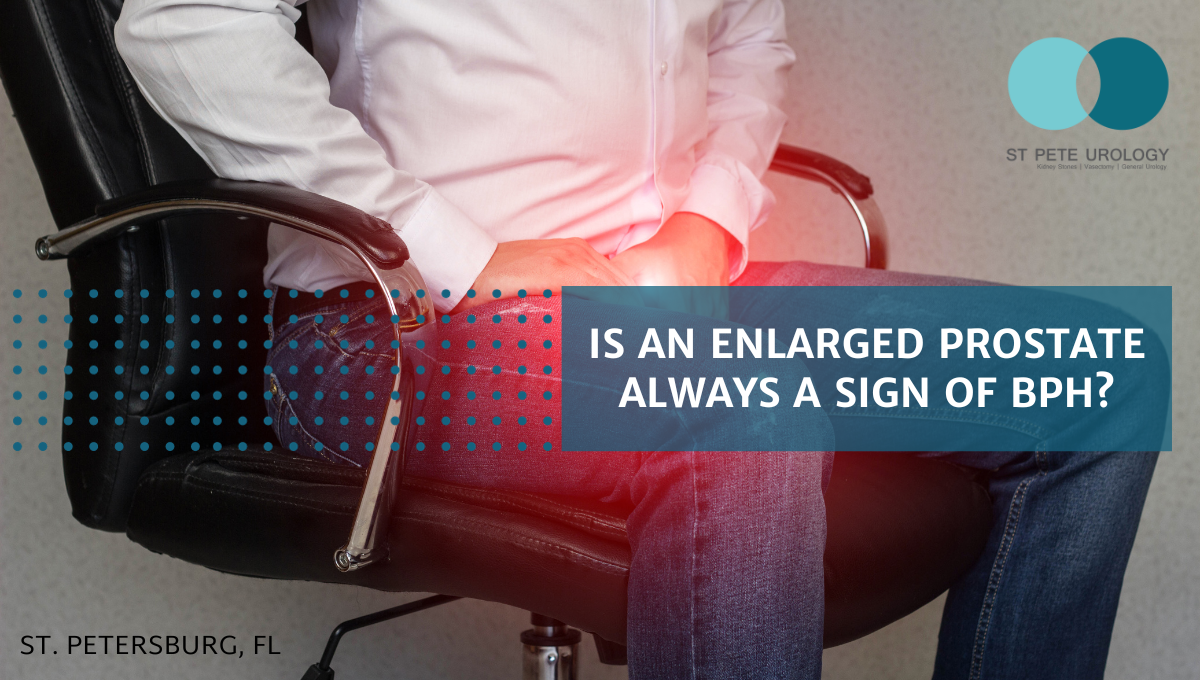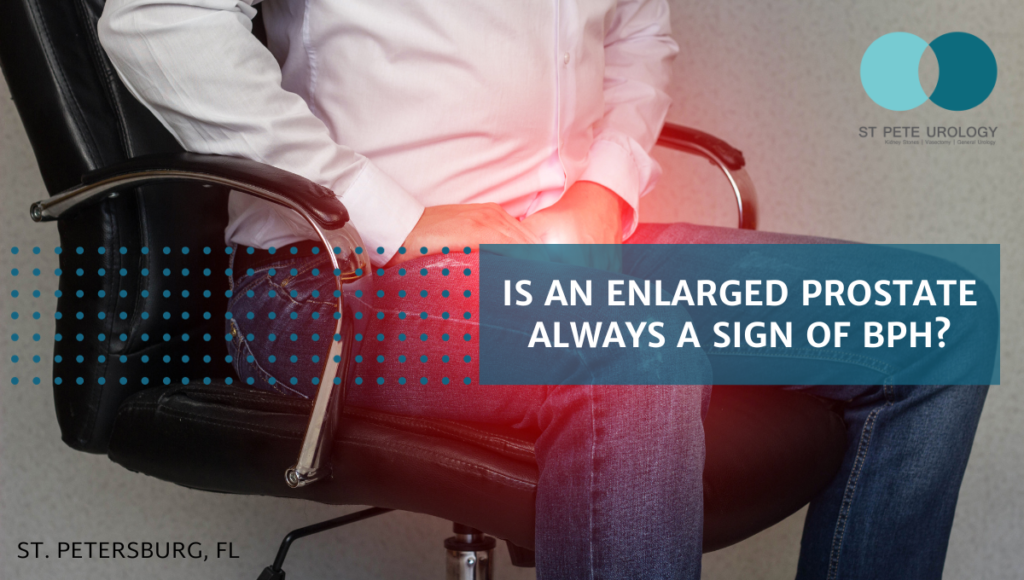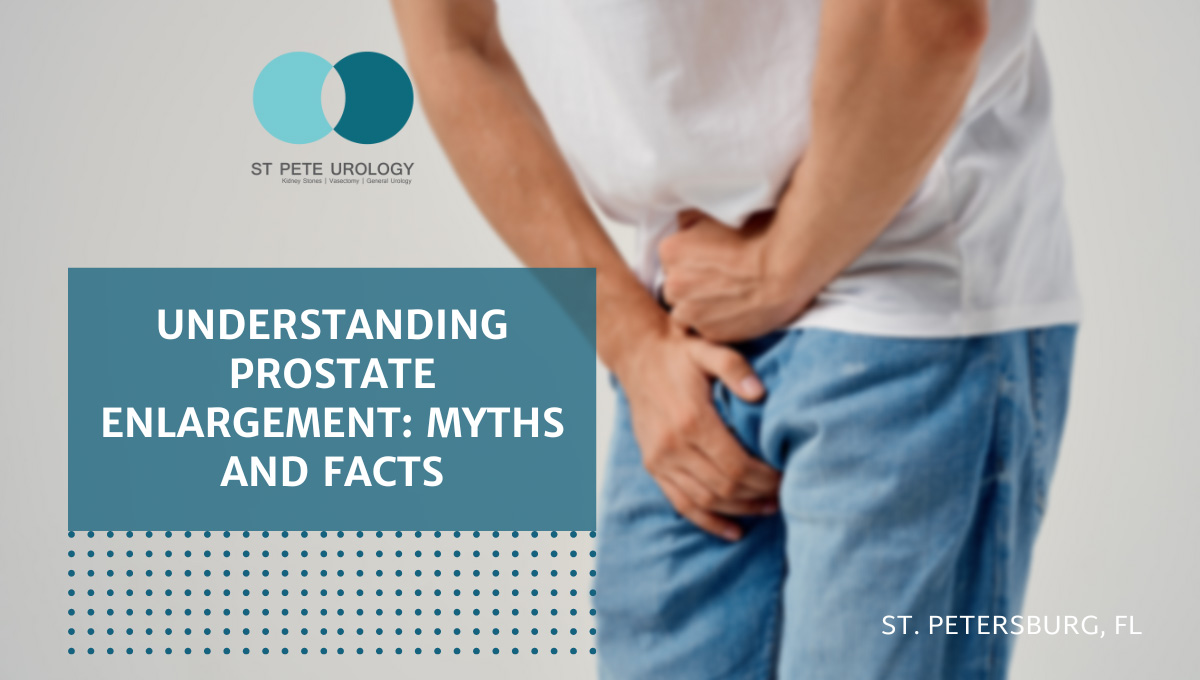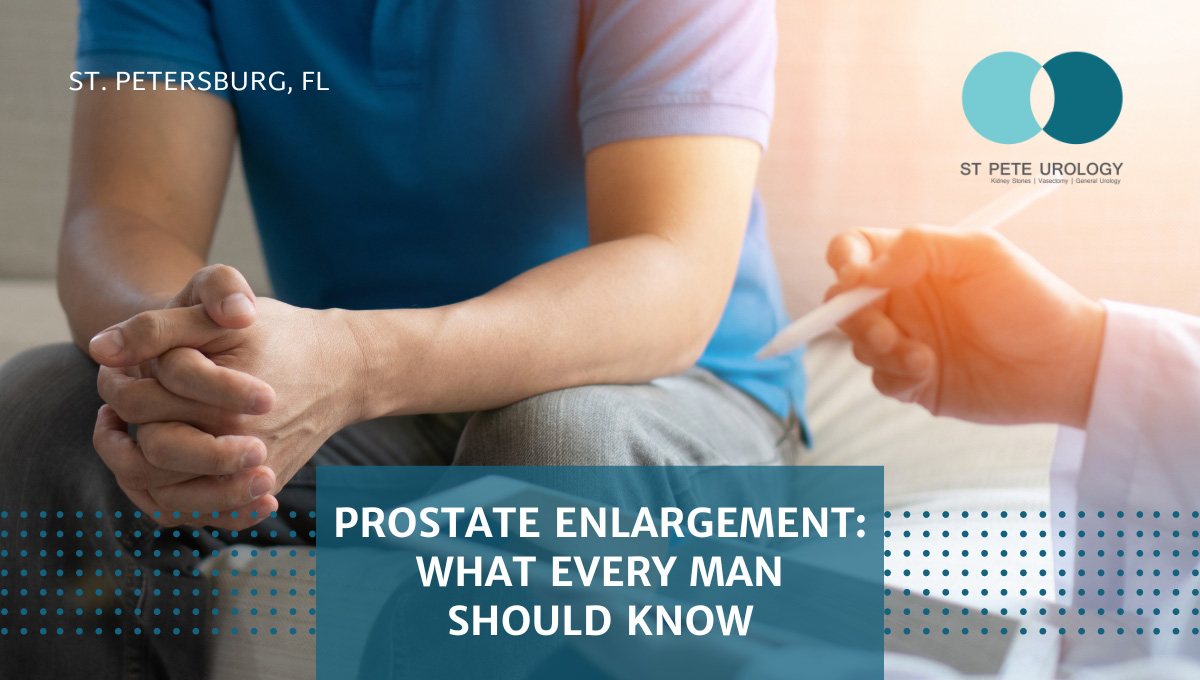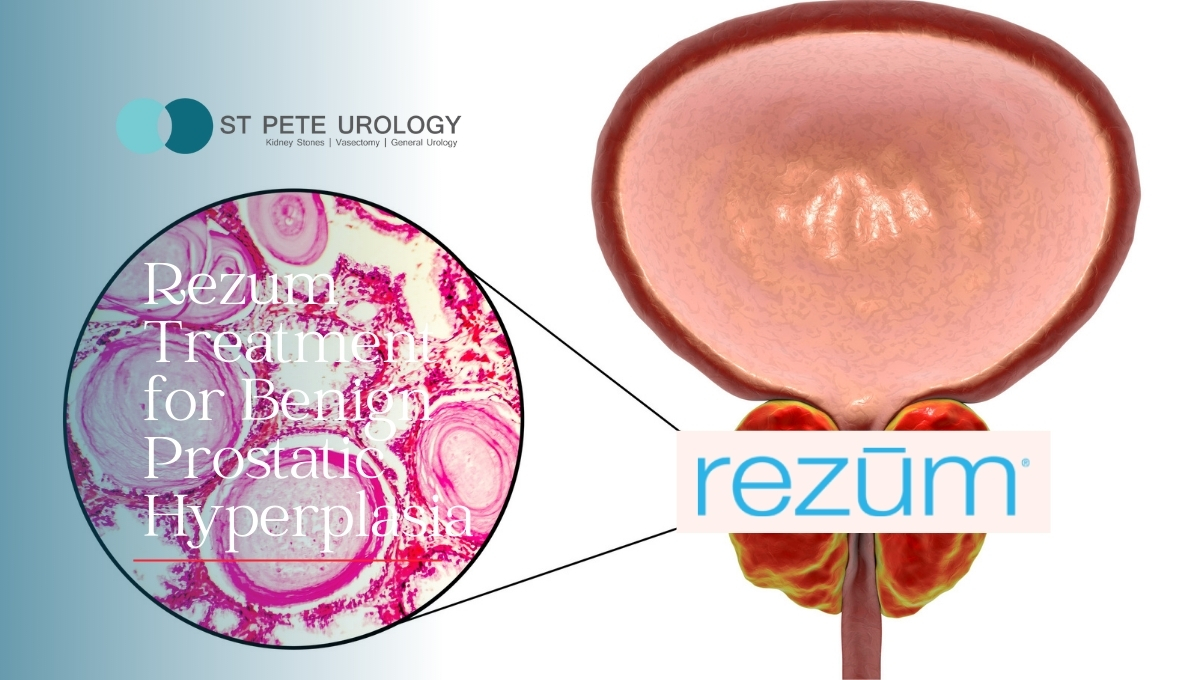Discover how HoLEP procedure and modern BPH treatments offer lasting relief from enlarged prostate symptoms with faster recovery. Expert care in St Petersburg, FL.
Continue readingWhat Are the Latest Treatments for Enlarged Prostate?
Explore the latest treatment for enlarged prostate, including minimally invasive options like Rezūm and Aquablation, to improve urinary symptoms effectively.
Continue readingHow Effective Are Non-Surgical Treatments for BPH?
How effective are non-surgical treatments for BPH? Understanding these treatments is a complex one, so find out more with St. Pete Urology.
Continue readingBPH (Enlarged Prostate): What Is It?
What is BPH or Enlarged Prostate? BPH is a condition that will affect the prostate of nearly every man at some point after the age of 40.
Continue readingIs an Enlarged Prostate Always a Sign of BPH?
Understanding Prostate Enlargement: Myths and Facts
How much of what you hear about prostate enlargement is true? Learn about the myths and misconceptions about prostate enlargement or BPH.
Continue readingProstate Enlargement: What Every Man Should Know
By the time you reach the golden age of fifty and beyond, it’s not uncommon to experience symptoms of an enlarged prostate. Learn more here.
Continue readingRezum Treatment for Benign Prostatic Hyperplasia
Benign prostatic hyperplasia (BPH), also called enlarged prostate, is a frustrating condition commonly occurring as men grow older.
Continue readingBPH: What Is It and What Causes It?
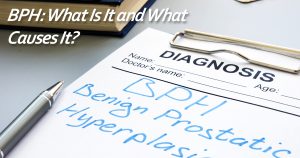 BPH is the abbreviation for benign prostatic hyperplasia, also called prostate gland enlargement, a condition commonly found in men as they age. Enlarged prostate glands can cause serious urinary issues such as blocked urine flow, urinary tract issues and kidney problems. The treatments for BPH include medications and minimally invasive surgery.The most common symptom is an urgent and frequent need to urinate. These may be accompanied by a difficulty beginning urination, a weak and interrupting stream, extended dribbles at the end of urination, or an inability to completely empty the bladder during urination. Urinary tract infections and bloody urine are other less common symptoms.
BPH is the abbreviation for benign prostatic hyperplasia, also called prostate gland enlargement, a condition commonly found in men as they age. Enlarged prostate glands can cause serious urinary issues such as blocked urine flow, urinary tract issues and kidney problems. The treatments for BPH include medications and minimally invasive surgery.The most common symptom is an urgent and frequent need to urinate. These may be accompanied by a difficulty beginning urination, a weak and interrupting stream, extended dribbles at the end of urination, or an inability to completely empty the bladder during urination. Urinary tract infections and bloody urine are other less common symptoms.
It is important to note that the size of the prostate does not necessarily correlate to the enlargement of the prostate. For instance, some men may have prostates that are only slightly enlarged and still suffer from symptoms worse than men with far greater enlarged prostates.
The prostate gland is found just below the bladder, and the tube that allows urine to exit the body runs directly through it. This is why urine flow is affected when the prostate enlarges. The primary cause of BPH is not fully known, but it may be related to changing sex hormone levels in men as they age.
The main risk factor for BPH is aging. Although BPH rarely affects men under 40, one-third of men between the ages of 40 and 60 experience it. And half of men experience it by age 80. Family history also plays a role in your chances of developing these problems. Men with a blood relative with BPH are more likely to develop it themselves. Diabetes, heart disease and obesity all increase the risk factors as well, while exercise helps lower them.
There are several complications that can result from BPH. The most common one is the inability to urinate, which may require a catheter if severe enough. Urinary tract infections can occur as well. Bladder stones and bladder damage may occur when the bladder cannot be fully emptied, which is more likely to happen to someone with BPH. Kidney damage is another complication that occurs when pressure that has built up in the bladder directly damages the kidneys.
Although common, BPH is a serious condition that can negatively affect quality of life and well being. But with many treatment options available, men can find relief by promptly seeking medical help. The doctors at St Pete Urology specialize in treating these issues and improving the lives of men as they age. For more information, visit the St Pete Urology website or make an appointment for a consultation.
GreenLight PVP Laser, a Great Treatment Option for BPH
Photo-selective Vaporization of Prostate (PVP) is increasingly becoming a popular method of treating benign prostatic enlargement (enlarged prostate or BPH). Using a combination of a high-powered laser beam and fiber optics to vaporize overgrowths of cells in the prostate, PVP helps to shrink the prostate gland quickly and accurately and swiftly relieves symptoms of Benign Prostatic Hyperplasia. The GreenLight Laser PVP is an alternative to the more common TURP (Transurethral Resection of Prostate). While the PVP procedure offers equal effectiveness in improving BPH symptoms, it’s simpler, has minimal short-term side effects, and offers quicker symptom relief, comfort and ease of urine flow.
How Is The Procedure Performed?
Conducted as an outpatient procedure by a urologist trained in the technique, the GreenLight Laser PVP requires nerve-blocking, spinal or general anesthesia along with sedation. During the procedure, the urologist inserts a cystoscope (tube supplied with light) via the urethra into the prostate, then runs a thin fiber through the cystoscope and places it in the urethra just adjacent to the obstruction. The urologist directs the laser at the prostate with intense pulses of light radiating from the ends of the fiber that are absorbed by blood.
As the blood absorbs light its temperature increases rapidly, heating up and vaporizing nearby cells. The surgeon continues to apply the laser light to destroy tissue overgrowth and reduce restriction on the urethra. The tissue that’s evaporated seals the blood vessels and reduces bleeding. The procedure takes roughly 40-60 minutes and a temporary catheter is usually inserted to help drain urine from the bladder.
So what are the benefits of Laser PVP?
- Minimal bleeding.
- Patients return home the same day.
- Return to normal activities in 2-3 days with caution.
- Only about 30 percent of patients require a post-op catheter.
- Return to strenuous activities in 4-6 weeks.
- Complications are rare, but quite mild if they occur.
- No post-operative impotence.
- PVP has not been associated with erectile dysfunction.
- Less likely to cause retrograde ejaculation.
- Lasting improvement in urine flow.
- Urinary obstruction is less likely with PVP.
Recovery after GreenLight Laser PVP
After laser PVP, patients remain in a recovery area where they are observed and prepared for discharge, typically within a few hours. If a temporary catheter is inserted, it’s usually removed 2-3 days after treatment, but may be left for a longer period in men who have had very severe symptoms or suffered prior bladder damage. During the first week following the procedure, a slight burning and discomfort may be experienced when urinating and small amounts of blood may occur in urine. While a dramatic improvement of symptoms and urine flow occurs within 1-2 days after the procedure, patients may still experience frequency and a sudden urge to pass urine for some time after treatment since the urethra is still adjusting to changes. And those with multiple health problems may not realize improvement that quickly.
Many men resume normal activities three days or so after laser PVP, but it’s recommended that they refrain from heavy lifting, pushing, strenuous exercise and vibrating equipment for at least 2 weeks because such activities may aggravate the urogenital area and cause bleeding. Sexual activity should be avoided for 2-3 weeks and only resumed when the patient is really comfortable doing so. It’s crucial to take things slowly and realize that it’ll take a while to get everything back to normal, including sexual desire. At times, retrograde ejaculation or reduced volume may occur, but these do not affect sexual pleasure or orgasm.
Is Laser PVP Safe?
The GreenLight Laser PVP is a significant improvement on the other minimally-invasive procedures used to treat BPH. It accurately vaporizes the overgrowth of the prostate gland without damaging any surrounding tissues and vessels. High-powered energy beams are delivered through a very thin laser fiber resulting in safe and precise vaporization of the overgrown tissue that’s blocking normal urine flow. As the high-pulsed laser removes the tissue causing blockage, it coagulates blood vessels and minimizes bleeding. Compared to other options for treating BPH, the GreenLight Laser PVP is much safer, simpler, faster, more precise and more effective. And most importantly, it allows quicker recovery than the other treatment options.
How does laser PVP compare with TURP?
Previously, effective BPH treatment required open prostatectomy — a major abdominal operation that needed a longer hospital stay and several months for recovery. But with the availability of instruments for accessing the prostate via the urethra instead of through the abdomen, TURP (transurethral resection of prostate) became the preferred treatment as it offered more safety, efficiency and effectiveness. However, there was still need for a better treatment that could offer quicker results, shorter recovery times and fewer long-term side-effects. The GreenLight Laser PVP has proven an improvement on TURP by being less invasive, delivering more immediate results and providing shorter recovery periods.
At St Pete Urology, we recommend transurethral vaporization procedures, most commonly the PVP GreenLight Laser and HoLAP (Holmium Laser Ablation), as alternatives for the previous gold standard TURP (Transurethral Resection of Prostate) because they are minimally-invasive outpatient operations with lower risks, durable results, safe use on large glands and patients on blood thinners, and high patient satisfaction. We perform the PVP GreenLight Laser on patients eligible for TURP, but discuss all the treatment options with our patients before we make a choice. For more information on treatment and care for BPH, visit the “St Pete Urology” site.

